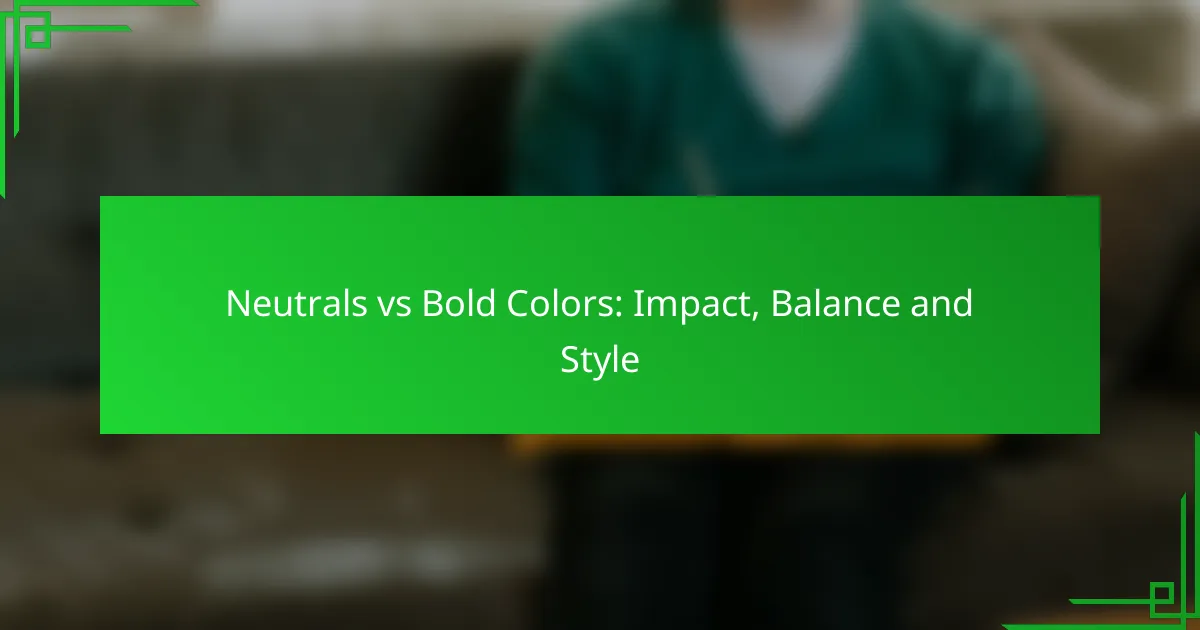Neutrals and bold colors play a crucial role in shaping the atmosphere and functionality of interior spaces. While neutrals foster a calming ambiance, bold colors inject energy and vibrancy, influencing both mood and perception. Striking the right balance between these palettes can create a visually appealing environment that resonates with personal style and current trends.

How do neutrals and bold colors impact interior design?
Neutrals and bold colors significantly influence the overall feel and functionality of interior spaces. Neutrals tend to create a serene environment, while bold colors can invigorate and energize a room, impacting mood and perception.
Neutrals create a calming atmosphere
Neutral colors, such as whites, beiges, and grays, foster a peaceful and tranquil environment. They serve as a versatile backdrop, allowing other elements in the room to shine without overwhelming the senses.
Incorporating neutrals can help in creating a cohesive look, especially in smaller spaces where a sense of openness is desired. Consider using varying shades of neutrals to add depth while maintaining a soothing ambiance.
Bold colors energize and stimulate
Bold colors like vibrant reds, blues, and yellows can inject energy and excitement into a space. These hues are often used in areas meant for social interaction or creativity, such as living rooms and offices.
When using bold colors, balance is key. Pairing them with neutral tones can prevent overwhelming the space while still allowing for dynamic visual interest. A single accent wall in a bold color can serve as a focal point without dominating the entire room.
Color psychology influences mood
The psychological effects of color can greatly influence how we feel in a space. For instance, blue is often associated with calmness, while yellow can evoke feelings of happiness and warmth.
Understanding color psychology can guide your choices in interior design. For example, using soft greens in a bedroom can promote relaxation, while brighter colors in a playroom can stimulate creativity and playfulness.
Contrast enhances visual interest
Using a mix of neutrals and bold colors creates contrast, which can enhance the visual appeal of a room. This interplay can draw attention to specific areas or features, making the space more engaging.
To achieve effective contrast, consider using bold colors in furniture or decor against a neutral backdrop. This strategy not only highlights the bold elements but also maintains a balanced and harmonious look throughout the space.

What are the best practices for balancing neutrals and bold colors?
To effectively balance neutrals and bold colors, consider the proportions and placement of each within your space. Utilizing established color rules and incorporating various elements can create a harmonious and visually appealing environment.
Use a 60-30-10 color rule
The 60-30-10 rule is a classic guideline for color distribution in design. This approach suggests that 60% of a space should be a dominant neutral color, 30% a secondary color (which can be bold), and 10% an accent color. This balance helps maintain visual interest without overwhelming the viewer.
For example, in a living room, you might use a soft beige for walls (60%), a deep blue for furniture (30%), and vibrant yellow for decorative pillows (10%). This method ensures that bold colors enhance rather than dominate the space.
Incorporate accent pieces
Accent pieces are vital for introducing bold colors without committing to them on a larger scale. Items such as throw pillows, artwork, or vases can serve as focal points that draw attention and add personality. Choose a few standout pieces that complement your neutral base.
For instance, if your room features gray walls, a bright red rug or a set of colorful art prints can create striking contrast and energize the space. This approach allows for flexibility in style and easy updates over time.
Consider lighting effects
Lighting significantly impacts how colors are perceived in a room. Natural light can enhance bold colors, making them appear more vibrant, while artificial lighting can soften or alter their appearance. Assess how different lighting conditions affect your color choices throughout the day.
For example, a bold orange may look warm and inviting in daylight but could appear harsh under fluorescent lights. Experiment with various light sources to find the best combination that showcases both neutrals and bold colors effectively.
Choose complementary color schemes
Complementary color schemes involve pairing colors that are opposite each other on the color wheel. This technique can create a dynamic and balanced look when integrating bold colors with neutrals. For instance, pairing a soft gray with a rich teal can provide a striking yet cohesive aesthetic.
When selecting complementary colors, consider the undertones in your neutrals. Warm neutrals pair well with warm bold colors, while cool neutrals work best with cool bold shades. This attention to detail ensures that the overall design feels intentional and well thought out.

Which neutrals and bold colors are trending in 2023?
In 2023, trending neutrals include soft shades like beige and gray, while bold colors feature vibrant tones such as emerald green and deep blue. These color choices reflect a balance between understated elegance and striking visual impact, catering to diverse design preferences.
Popular neutrals: beige, gray, taupe
Beige, gray, and taupe are the leading neutral colors this year, offering versatility in various settings. These shades can create a calming backdrop, making them ideal for both residential and commercial spaces.
When incorporating these neutrals, consider using them in larger areas like walls or furniture to establish a cohesive look. Pairing them with textured materials, such as wood or fabric, can add depth and interest to the overall design.
Trending bold colors: emerald green, deep blue, terracotta
Emerald green, deep blue, and terracotta are standout bold colors that are gaining popularity in 2023. These hues can energize a space and create focal points that draw attention.
To effectively use bold colors, consider accenting with accessories like cushions, artwork, or decorative pieces. This approach allows for easy updates without overwhelming the overall aesthetic. Additionally, combining bold colors with neutrals can achieve a balanced and harmonious look.

How can neutrals and bold colors affect buyer decisions?
Neutrals and bold colors significantly influence buyer decisions by shaping perceptions of value and brand identity. While neutrals often convey sophistication and reliability, bold colors can evoke excitement and urgency, impacting how consumers feel about a product.
Color influences perceived value
The choice of color can alter how consumers perceive the value of a product. Neutrals like beige, gray, and white tend to suggest elegance and timelessness, often appealing to buyers looking for quality. In contrast, bold colors such as red or blue can create a sense of urgency or excitement, which may drive impulse purchases.
For example, luxury brands frequently use neutral palettes to communicate exclusivity, while clearance sales might employ bright colors to attract attention. Understanding the psychological impact of color can help businesses tailor their marketing strategies effectively.
Brand identity relies on color choices
Color choices are integral to establishing a brand’s identity. Brands often select specific colors to convey their values and connect with their target audience. For instance, green is commonly associated with sustainability, while blue can evoke trust and dependability.
Consistent use of color across branding materials, such as logos and packaging, reinforces brand recognition. Companies should consider their audience’s cultural associations with colors, as these can vary significantly across different regions. For example, while white symbolizes purity in many Western cultures, it may represent mourning in some Eastern cultures.

What are the common mistakes when using color in design?
Common mistakes in color usage include overusing bold colors and neglecting color harmony, both of which can detract from the overall design. Understanding these pitfalls can help create a more balanced and visually appealing outcome.
Overusing bold colors can overwhelm
Using too many bold colors can create a chaotic visual experience, making it difficult for viewers to focus on the intended message. A good rule of thumb is to limit bold colors to one or two focal points in a design, allowing them to stand out without competing for attention.
For example, if a website uses a vibrant red for buttons, it should balance this with neutral backgrounds or softer hues to avoid overwhelming users. This approach helps maintain clarity and enhances user engagement.
Neglecting color harmony leads to discord
Color harmony is crucial for creating a cohesive design. Ignoring the relationships between colors can result in a jarring visual experience that distracts from the content. Utilizing color theory principles, such as complementary or analogous color schemes, can help achieve a harmonious look.
When selecting colors, consider using tools like color wheel applications to visualize combinations. Aim for a balanced palette where no single color dominates, ensuring that all elements work together to convey the desired message effectively.

How to choose colors for specific rooms?
Choosing colors for specific rooms involves understanding the mood and function of each space. Consider how neutrals and bold colors can impact the atmosphere and balance of the room.
Consider the room’s purpose
The purpose of a room significantly influences color selection. For example, calming colors like soft blues or greens work well in bedrooms, while vibrant colors like yellows or reds can energize a kitchen or playroom. Assess how you want the space to feel and function.
Evaluate natural light
Natural light affects how colors appear in a room. Rooms with ample sunlight can handle bolder colors without feeling overwhelming, while darker spaces may benefit from lighter, neutral shades to enhance brightness. Test paint samples in different lighting conditions to see how they change throughout the day.
Balance with furnishings
Consider the existing furnishings and decor when choosing colors. Neutrals can provide a versatile backdrop that complements various styles, while bold colors can make a statement against more subdued furniture. Aim for a cohesive look by selecting colors that harmonize with your existing palette.
Test before committing
Always test colors before making a final decision. Purchase sample pots and paint small areas to see how the colors work in your space. This step helps avoid costly mistakes and ensures the chosen colors align with your vision.
